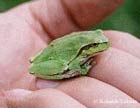Ways of managing Lake Durbe Meadows will be discussed On Friday, December 1 at 11.00 will be held the last supervisory group discussion on management plan of the nature reserve “Lake Durbe Meadows” in the Durbe Culture Centre, informs Mr. Rolands Lebuss, the leader of the plan development from the Latvian Ornithological Society.  | | Common Tree Frog (Hyla arborea) | | in Lake Durbe meadows | Ways of managing Lake Durbe Meadows will be discussed On Friday, December 1 at 11.00 will be held the last supervisory group discussion on management plan of the nature reserve “Lake Durbe Meadows” in the Durbe Culture Centre, informs Mr. Rolands Lebuss, the leader of the plan development from the Latvian Ornithological Society. Mr. Rolands Lebuss emphasizes that the management plan is a tool for helping to ensure a balanced territorial protection and management considering the priorities of the nature protection. In this plan should be long-term and short-term goals of territorial protection, territorial zoning if necessary (for wide and heterogeneous or diverse areas) and foreseen measures in order to reach the goals. In this plan will be stated possibilities for the future territorial management and protection for the period of next ten years. Within the framework of LIFE-Nature project “Restoration of Floodplains” the management plan for the nature reserve “Lake Durbe Meadows” is being developed by the Latvian Ornithological Society and it is developed for the period 2007-2016. The nature reserve “Lake Durbe Meadows” was established in the year 2004 in order to ensure the protection of the unique value of nature, mainly the rare and especially protected wild bird and plant species, as well as habitat protection. Since the year of 2004 the nature park is a territory of Natura 2000 network and this park covers 596 ha which administratively is included in the territory of Durbe municipality, in Dunalka and Vecpils parishes. The nature reserve includes a part of the place which is internationally important bird area. This is the site where large flocks of geese are concentrated during the autumn bird migration, as well as during the nesting period there is also a wide range of Corncrakes registered in this site. From the rarest types of meadow habitats there are Fennoscandian lowland species-rich mesic grasslands, as well as Lowland hay meadows. The status of the Natura 2000 prescribes an international responsibility for conservation of nature values. Consequently, any kind of management executed in the nature reserve primarily should be evaluated by its possible impact on the preservation of the nature values. However, certain managing activities are even necessary here. Majority of meadows and pastures in flooded areas are overgrown and covered with bushes. They are not managed, though the land owners are paying the land tax. There are places where the only hosts is beaver, overflowing even wider areas. The meadow restoration would ensure the necessary living place for the moist meadow plant and animal species. Apart from Corncrake, Lesser Spotted Eagle should be mentioned as well because the floodplains are favoured by these birds for feeding. That is the same about Great Snipe – bird who already in the period of the Dukedom of Kurzeme was regarded as one of relatively common birds for hunting, but currently is extinct already in Kurzeme. One of the last mating-places of Grat Snipes was directly on the shores of Lake Durbe. Meadow restoration gives a hope to attract these birds in their historical place of living. Presently, within the framework of the project “Restoration of Floodplains” there are concluded agreements on cutting down bushes in the overgrown meadows of more than 30 ha and on proceeding with initial mowing of meadows in the area of 40 ha. The interest about the management of meadows has promoted landscape changes already currently by developing open areas of floodplain meadows. “It gives us a hope that maybe some day during the spring time Great Snipes will return and throughout the midnight will start their leking fights in their fighting spirit,” notes Mr. Jânis Reihmanis, the regional project coordinator from the Latvian Fund for Nature. The latest version of the nature conservation plan which will be included in public discussion is available here (on Latvian), as well as in local authorities. | 






